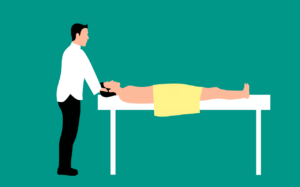
If you’re one of the many people who experience shoulder pain from sleeping on your side, you’ll be relieved to know that there are effective solutions to help alleviate your discomfort. This article will explore various methods and techniques that can provide relief and promote a more comfortable night’s rest. Whether it’s adjusting your sleeping position, investing in a supportive pillow, or incorporating stretching exercises into your daily routine, these solutions will help you bid farewell to shoulder pain and wake up feeling refreshed and pain-free.

Causes of Shoulder Pain from Side Sleeping
Improper pillow support
One of the primary causes of shoulder pain when sleeping on your side is the lack of proper pillow support. If your pillow is too thin or too thick, it can lead to discomfort and strain on your shoulder. An inadequate pillow fails to provide the necessary support to keep your neck and shoulder aligned, resulting in pain and stiffness.
Wrong sleeping position
Another common cause of shoulder pain is adopting the wrong sleeping position. When you sleep on your side, it is crucial to ensure that your shoulder is properly aligned with the rest of your body. Placing your arm under your head or not supporting it adequately can strain the muscles and put pressure on the shoulder joint, causing pain.
Muscle imbalances
Muscle imbalances can also contribute to shoulder pain from side sleeping. These imbalances occur when certain muscles are stronger or tighter than others, causing the shoulder joint to be pulled out of alignment. Sleeping on your side can exacerbate these imbalances, resulting in discomfort and pain.
Rotator cuff injuries
Side sleeping can put stress on the rotator cuff, a group of muscles and tendons that stabilize the shoulder joint. If you have an existing rotator cuff injury or weakness, sleeping on your side can exacerbate the problem and lead to shoulder pain. Injuries to the rotator cuff can cause aching, weakness, and limited range of motion in the shoulder.
Arthritis
Arthritis, particularly in the shoulder joint, can cause significant pain when sleeping on your side. The pressure placed on the inflamed joint can intensify discomfort and make it difficult to find a comfortable sleeping position. If you have arthritis in your shoulder, it is essential to take steps to minimize the impact on your sleep.
Choosing the Right Pillow
Understanding pillow thickness
The thickness of your pillow plays a crucial role in minimizing shoulder pain when sleeping on your side. Ideally, you should choose a pillow that keeps your head and neck aligned with your spine, ensuring proper support for your shoulder. Pillows that are too thick or too thin can strain your shoulder and lead to discomfort.
Choosing a supportive pillow
When selecting a pillow for side sleeping, opt for one that provides sufficient support for your shoulder and neck. Look for pillows specifically designed for side sleepers, as they usually have a contoured shape that promotes proper spinal alignment. Memory foam or latex pillows are often good choices as they conform to the shape of your head and neck, offering personalized support.
Considering pillow materials
Aside from the thickness and support, the material of your pillow can also affect your shoulder’s comfort. Some materials, such as memory foam or latex, offer better contouring and pressure relief, while others may be more firm and supportive. Consider your personal preferences and any allergies you may have when choosing the pillow material.
Using additional pillows for support
In some cases, using additional pillows can provide extra support and alleviate shoulder pain. Placing a pillow between your knees can help maintain proper spinal alignment and reduce pressure on your shoulder. You can also try placing a small pillow or rolled towel under your armpit to support your arm and prevent it from falling forward during sleep.

Correcting Sleeping Position
Using a body pillow for alignment
A body pillow can be a valuable tool for aligning your spine and shoulders when sleeping on your side. Placing the body pillow lengthwise along your body allows you to rest your upper arm on it, keeping your shoulder in a neutral position. This alignment helps minimize strain on the shoulder joint and can alleviate pain and discomfort.
Sleeping on the opposite side
If you consistently experience shoulder pain when sleeping on one side, try switching to the opposite side. By alternating your sleeping position, you can distribute the pressure and avoid overloading one shoulder. It may take some time to adjust to the new position, but it can significantly reduce shoulder pain in the long run.
Utilizing a recliner chair
If switching sides or adjusting your pillow doesn’t alleviate your shoulder pain, you may want to consider sleeping in a recliner chair. Recliners provide better support and allow you to find a more comfortable position while sleeping on your side. The adjustable backrest and footrest help distribute your weight evenly, reducing pressure on your shoulders.
Experimenting with different positions
Sometimes, finding relief from shoulder pain requires experimentation with different sleeping positions. You can try sleeping slightly inclined, using a wedge pillow or propping up your upper body with additional pillows. This position can take the pressure off your shoulder while still allowing you to sleep on your side comfortably. If none of these options work, consulting a healthcare professional for guidance may be beneficial.
Exercises and Stretches for Shoulder Pain Relief
Rotator cuff strengthening exercises
Strengthening the rotator cuff muscles can help improve shoulder stability and reduce pain. Simple exercises like resistance band external rotations or internal rotations can be beneficial. Start with light resistance and gradually increase as your strength improves. These exercises should be performed under the guidance of a physiotherapist or healthcare professional to ensure proper form and avoid further injury.
Shoulder blade squeezes
Shoulder blade squeezes are an effective exercise for reducing tension in the upper back and shoulders. Stand against a wall with your feet shoulder-width apart and your back flat against the wall. Squeeze your shoulder blades together, hold for a few seconds, and then release. Repeat this exercise several times a day to help relieve shoulder pain caused by muscle imbalances.
Trapezius stretches
Stretching the trapezius muscles, which run along the upper back and neck, can help alleviate shoulder pain. One simple stretch involves sitting or standing upright with your arms relaxed at your sides. Gently tilt your head towards one shoulder, bringing your ear closer to your shoulder. Hold for 15-30 seconds, then repeat on the other side. Repeat this stretch several times on each side to release tension in the trapezius muscles.
Pectoralis major stretches
Tightness in the chest muscles, specifically the pectoralis major, can contribute to shoulder pain. Stretching these muscles can help relieve tension and restore flexibility. Stand near a doorway with your arm outstretched at shoulder height and your elbow bent at a 90-degree angle. Place your forearm against the doorframe and gently lean forward, feeling a stretch in your chest. Hold for 15-30 seconds, then repeat on the other side. Perform this stretch regularly to improve shoulder mobility.
Physical therapy exercises
If you experience persistent shoulder pain, it is advisable to consult a physical therapist for a tailored exercise program. A physical therapist can assess your specific condition and design exercises that target your individual needs. Physical therapy exercises often focus on improving range of motion, strengthening the surrounding muscles, and correcting any imbalances that may contribute to shoulder pain.

Heat and Cold Therapy
Applying heat packs
Heat therapy can be beneficial for easing shoulder pain by increasing blood flow and relaxing the muscles. Apply a heat pack or a hot water bottle to your shoulder for 15-20 minutes at a time. Make sure to wrap the heat source in a thin cloth to prevent burns. You can use heat therapy before stretching or exercising to warm up the muscles and reduce discomfort.
Using cold compresses
Cold therapy can help reduce inflammation and numb the area, providing temporary relief from shoulder pain. Apply a cold compress or an ice pack wrapped in a thin towel to your shoulder for 15-20 minutes at a time. Take regular breaks between applications to prevent skin damage. Cold therapy is particularly useful immediately after an injury or if your shoulder feels swollen or inflamed.
Alternating between hot and cold therapy
Some individuals find relief from shoulder pain by alternating between hot and cold therapy. This method, known as contrast therapy, involves using both hot and cold applications in succession. Start with heat therapy for a few minutes, then switch to cold therapy for a few minutes. Continue alternating between the two for a desired duration. This technique can help increase blood flow, reduce inflammation, and alleviate pain.
Duration and frequency of therapy
When using heat or cold therapy, it is essential to consider the duration and frequency of application. Heat therapy should be applied for 15-20 minutes at a time, while cold therapy should be used for the same duration. It is advisable to wait at least 45 minutes to an hour before reapplying either therapy to prevent tissue damage. Consult a healthcare professional if you are unsure about the appropriate duration or frequency for your specific condition.
Over-the-Counter Pain Relief
Nonsteroidal anti-inflammatory drugs (NSAIDs)
Over-the-counter nonsteroidal anti-inflammatory drugs (NSAIDs), such as ibuprofen or naproxen sodium, can help alleviate shoulder pain caused by inflammation. These medications can reduce swelling and relieve pain temporarily. It is important to follow the recommended dosage guidelines and consult a healthcare professional if you have any underlying health conditions or concerns.
Topical creams and ointments
Topical creams and ointments containing ingredients like menthol or capsaicin can provide localized relief for shoulder pain. These products work by numbing the area and reducing the sensation of pain. Apply the cream or ointment to the affected shoulder following the instructions on the packaging. Be cautious of any allergies or skin sensitivities and discontinue use if irritation occurs.
Pain relief patches
Pain relief patches can be a convenient option for managing shoulder pain. These patches typically contain ingredients like lidocaine or menthol, which are absorbed through the skin and provide localized relief. Apply the patch directly to the affected shoulder, following the instructions on the packaging. Check for any allergies or skin sensitivities before using pain relief patches.
Improving Posture
Ergonomic workspace setup
Maintaining good posture throughout the day, including at work, can help prevent or alleviate shoulder pain. When sitting at a desk, ensure that your chair provides adequate support for your back and shoulders. Adjust the height of your chair and desk so that your arms can rest comfortably on the keyboard. Use a footrest if necessary to keep your knees at a 90-degree angle. Proper ergonomic setup promotes better posture and reduces strain on the shoulders.
Practicing good posture throughout the day
In addition to an ergonomic workspace setup, practicing good posture throughout the day is essential for shoulder health. Avoid slouching or hunching your shoulders forward when standing or sitting. Instead, imagine a string pulling the top of your head towards the ceiling, elongating your spine, and keeping your shoulders relaxed. Regularly check in with your posture and make necessary adjustments to maintain proper alignment.
Strengthening core muscles
Having a strong core can contribute to overall postural stability, which can alleviate shoulder pain. Core exercises like planks, Russian twists, or Pilates can help strengthen the muscles that support proper posture. Incorporate these exercises into your regular workout routine to promote a stronger core and improved shoulder alignment.
Physical therapy for postural correction
If poor posture is a persistent issue and contributing to your shoulder pain, seeking the guidance of a physical therapist can be beneficial. Physical therapists can assess your posture and design exercises to correct postural abnormalities. They can also provide targeted stretches and techniques to alleviate any related pain or discomfort. Working with a physical therapist can help you establish healthy habits and improve your overall posture to prevent future shoulder pain.
Rest and Recovery
Importance of rest
Rest is crucial for allowing your body to recover from any injuries or daily wear and tear. If you experience shoulder pain from side sleeping, ensure that you prioritize rest and give your body time to heal. Avoid overdoing activities that worsen the pain, and listen to your body’s signals for when it needs rest.
Avoiding strenuous activities
While it is important to stay active and maintain overall fitness, it is advisable to avoid strenuous activities that may aggravate your shoulder pain. Give your shoulder time to rest and recover before engaging in activities that involve repetitive or heavy shoulder movements. Consult a healthcare professional if you are unsure about the appropriateness of certain activities for your condition.
Using supportive aids during sleep
To promote restful sleep and aid in shoulder recovery, consider using supportive aids during sleep. A body pillow or additional pillows strategically placed can help maintain proper alignment and minimize pressure on the affected shoulder. Additionally, you may want to explore products such as shoulder braces or slings that provide support and immobilization during sleep, especially if you have suffered a shoulder injury.
Incorporating relaxation techniques
Stress and tension can contribute to shoulder pain and discomfort. Incorporating relaxation techniques such as deep breathing exercises, meditation, or gentle stretching before bed can help relax the muscles and promote better sleep. Creating a calming bedtime routine can also help signal to your body that it is time to unwind and prepare for rest and recovery.
When to Seek Medical Help
Persistent or worsening pain
If you experience persistent or worsening shoulder pain from side sleeping despite trying various home remedies and lifestyle adjustments, it may be time to seek medical help. A healthcare professional can assess your condition, provide an accurate diagnosis, and recommend appropriate treatments or therapies to alleviate your shoulder pain.
Limited range of motion
If your shoulder pain is accompanied by limited range of motion, such as difficulty raising your arm or reaching behind your back, it is advisable to consult a healthcare professional. Limited range of motion can indicate a more severe underlying condition, such as a rotator cuff tear or frozen shoulder, which may require specialized treatment.
Signs of infection or inflammation
If your shoulder pain is accompanied by signs of infection or inflammation, such as redness, warmth, swelling, or fever, it is essential to seek immediate medical attention. These symptoms may indicate an infection or a more serious condition that requires prompt evaluation and treatment.
Seeking professional diagnosis
If your shoulder pain is interfering with your daily activities or significantly affecting your quality of life, seeking a professional diagnosis is advisable. A medical professional, such as an orthopedic specialist or a physiotherapist, can perform a thorough evaluation, order any necessary imaging tests, and provide a tailored treatment plan based on your specific condition.
Prevention Tips for Shoulder Pain
Maintaining a healthy weight
Maintaining a healthy weight is beneficial for overall joint health, including the shoulders. Excess weight can put additional stress on the joints, leading to increased discomfort and a higher risk of injuries. Adopting a balanced diet and engaging in regular physical activity can help achieve and maintain a healthy weight, reducing the strain on your shoulders.
Regular exercise and stretching
Regular exercise and stretching can help strengthen the muscles surrounding the shoulder joint and improve flexibility. Engaging in activities that target the shoulders, such as shoulder rolls, wall push-ups, or resistance band exercises, can help prevent muscle imbalances and promote overall shoulder health. Consult a healthcare professional or a qualified trainer for guidance on appropriate exercises for your specific needs.
Daily shoulder mobility exercises
Performing daily shoulder mobility exercises can help keep the joint lubricated and reduce the risk of stiffness or pain. Simple exercises like shoulder circles, pendulum swings, or arm raises can improve flexibility and maintain joint health. Incorporate these exercises into your daily routine to promote shoulder mobility and prevent discomfort.
Choosing an appropriate mattress
The mattress you sleep on can significantly impact your shoulder health. Opt for a mattress that provides adequate support and cushioning for your shoulders. Medium-firm mattresses generally offer a good balance of support and comfort. Consider testing different mattresses or consulting with a mattress specialist to find the most suitable option for your sleeping style and shoulder needs.
By addressing the causes of shoulder pain from side sleeping, choosing the right pillow and sleeping position, incorporating exercises and stretches, utilizing heat and cold therapy, and taking rest and recovery seriously, you can find relief from shoulder pain and improve your overall shoulder health. Remember, if your shoulder pain persists or worsens despite home remedies, it is important to seek medical help for proper diagnosis and treatment. With the right approach and care, you can enjoy restful nights and pain-free shoulders.







